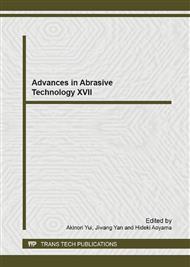p.3
p.9
p.15
p.21
p.27
p.33
p.38
p.44
On the Profile and Microstructure Variations of Grinding-Induced Hardening Layer in A Cylindrical Workpiece
Abstract:
Grinding-hardening is a thermo-mechanical process capable of simultaneous material removal and surface enhancement. However, there are difficulties in dealing with cylindrical workpieces, because of the complex 3D-helical movement of the grinding-induced heat source. This paper investigates the effects of some key grinding parameters on the profile and microstructure variations of the hardened layer generated by a traverse cylindrical grinding, both experimentally and numerically. It was found that the ratio of the longitudinal wheel feed to the rotational speed of the workpiece R is most influential on the hardened layer profile. A larger R results in a thicker hardened layer but a more pronounced discontinuity of two adjacent hardening zones. Although a smaller R yields a relatively thinner hardened layer, the non-uniformity could be minimised by the overlapping of the grinding heating. The microstructure of the hardened layer can be altered by the tempering in subsequent grinding heating. A thermal analysis with the aid of the finite element method in conjunction with an experimental microstructural examination showed that the temperature distribution in the tempered region would lead to a variation of the precipitated carbide, and that a higher tempering temperature could result in a higher degree of the carbide precipitation and a more significant reduction of hardness.
Info:
Periodical:
Pages:
3-8
Citation:
Online since:
September 2014
Authors:
Price:
Сopyright:
© 2014 Trans Tech Publications Ltd. All Rights Reserved
Share:
Citation:


